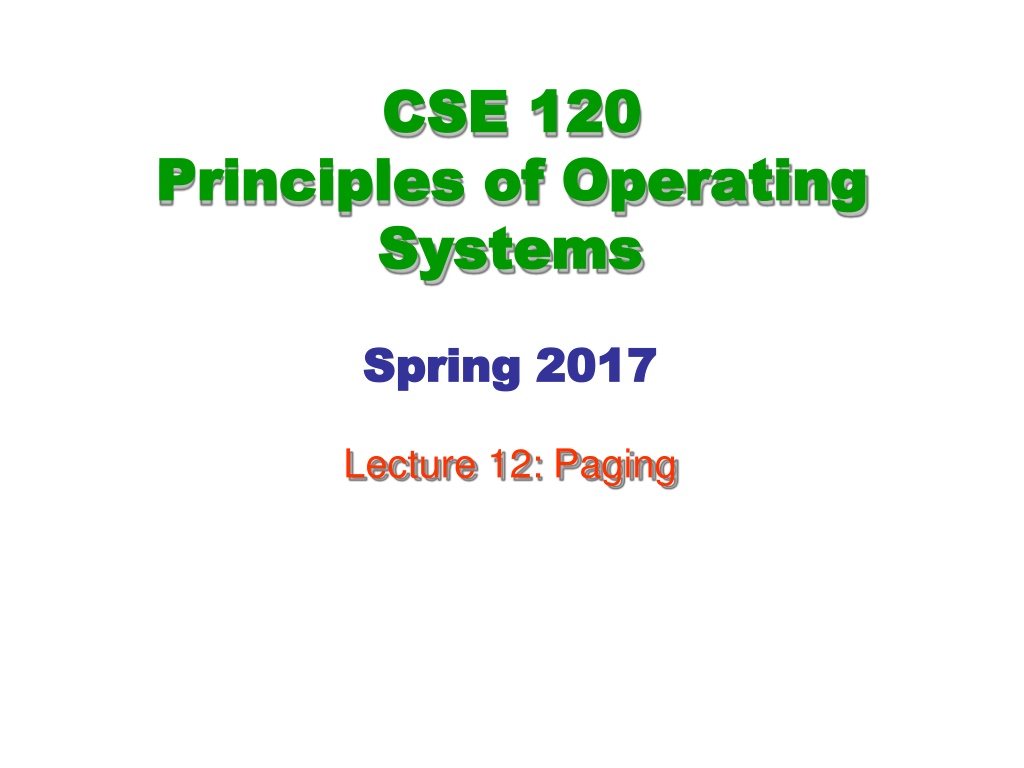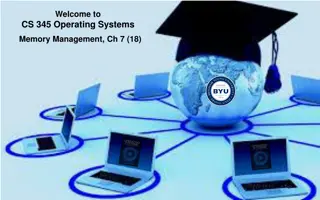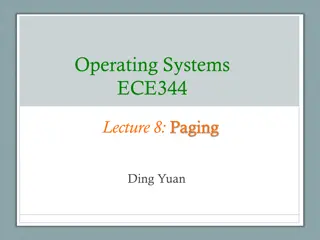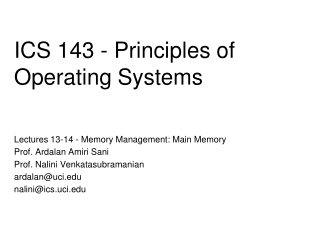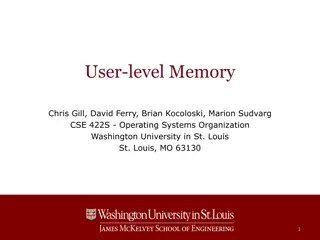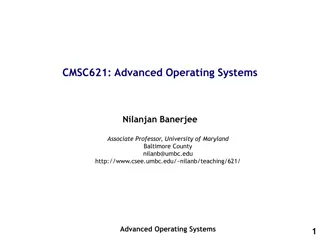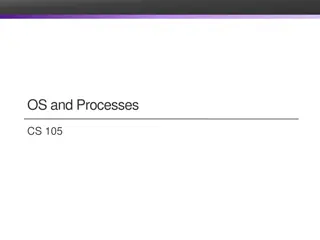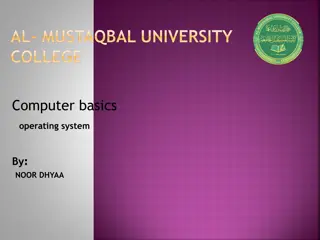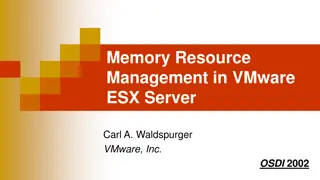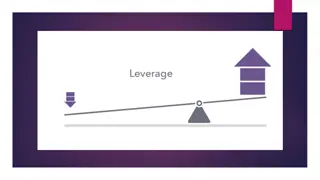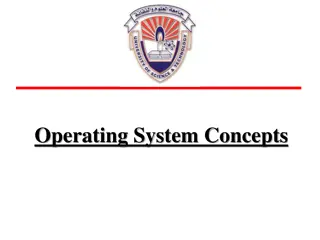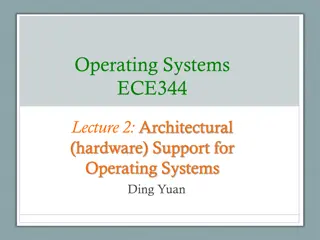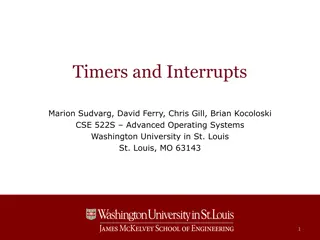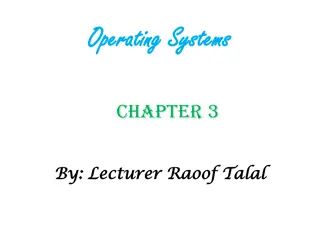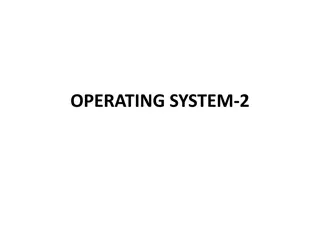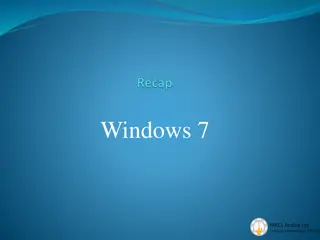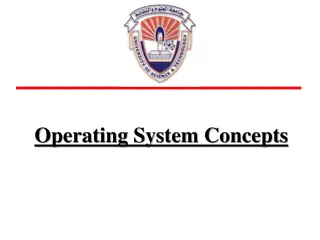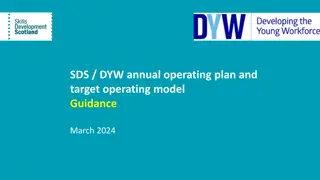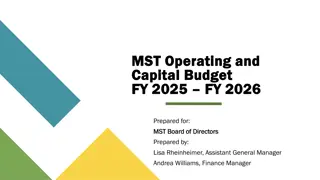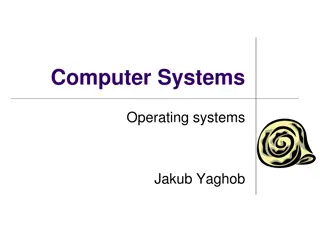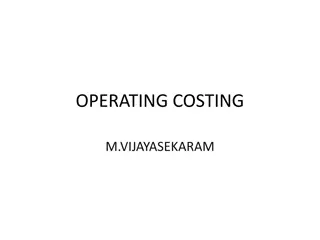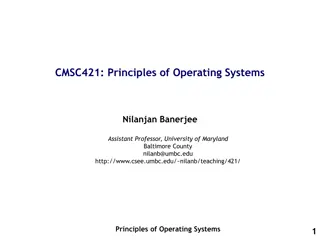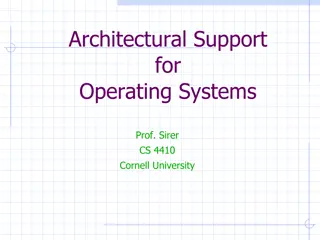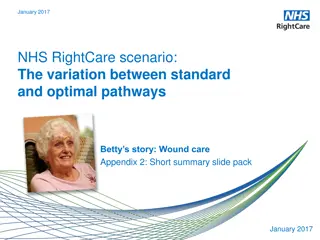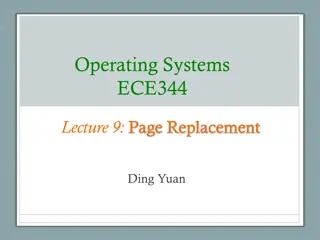Paging Mechanisms and Optimal Management in Operating Systems
Covering more paging mechanisms in operating systems, this lecture delves into optimizations for managing page tables efficiently, including techniques like TLBs and demand-paged virtual memory. The focus is on reducing overhead in page table management by mapping only the used address space and implementing two-level page tables for more efficient translations. Evolution of page tables and advanced functionalities like memory sharing and copy on write are also discussed.
Uploaded on Sep 27, 2024 | 0 Views
Download Presentation

Please find below an Image/Link to download the presentation.
The content on the website is provided AS IS for your information and personal use only. It may not be sold, licensed, or shared on other websites without obtaining consent from the author. Download presentation by click this link. If you encounter any issues during the download, it is possible that the publisher has removed the file from their server.
E N D
Presentation Transcript
CSE CSE 120 of Operating Operating Systems Systems 120 Principles Principles of Spring Spring 201 2017 7 Lecture 12: Paging
Lecture Lecture Overview Overview Today we ll cover more paging mechanisms: Optimizations Managing page tables (space) Efficient translations (TLBs) (time) Demand paged virtual memory (space) Recap address translation Advanced Functionality Sharing memory Copy on Write Mapped files CSE 120 Lecture 10 Paging November 5,2015 2
Managing Managing Page Page Tables Tables Last lecture we computed the size of the page table for a 32-bit address space w/ 4K pages to be 4MB This is far far too much overhead for each process How can we reduce this overhead? Observation: Only need to map the portion of the address space actually being used (tiny fraction of entire addr space) How do we only map what is being used? Can dynamically extend page table Does not work if addr space is sparce (internal fragmentation) Use another level of indirection: two-level page tables CSE 120 Lecture 10 Paging November 5,2015 3
Two Two- -Level Page Level Page Tables Tables Two-level page tables Virtual addresses (VAs) have three parts: Master page number, secondary page number, andoffset Master page table maps VAs to secondary page table Secondary page table maps page number to physical page Offset indicates where in physical page address is located Example 4K pages, 4 bytes/PTE How many bits in offset? 4K = 12 bits Want master page table in one page: 4K/4 bytes = 1K entries Hence, 1K secondary page tables. How many bits? Master (1K) = 10, offset = 12, inner = 32 10 12 = 10 bits CSE 120 Lecture 10 Paging November 5,2015 4
Two Two- -Level Page Level Page Tables Tables Physical Memory VirtualAddress Master page number Secondary Offset PhysicalAddress Pageframe Page table Offset Master Page Table Pageframe Secondary Page Table CSE 120 Lecture 10 Paging November 5,2015 5
Page Table Page Table Evolution Evolution VirtualAddress Space Page 0 Physical Memory Linear (Flat) PageTable Page 1 Page 2 Page N-1 CSE 120 Lecture 10 Paging November 5,2015 6
Page Table Page Table Evolution Evolution Hierarchical PageTable VirtualAddress Space Page 0 Physical Memory Secondary Page 1 Page 2 Master Page N-1 CSE 120 Lecture 10 Paging November 5,2015 7
Page Table Page Table Evolution Evolution Hierarchical PageTable VirtualAddress Space Page 0 Physical Memory Secondary Page 1 Page 2 Master Not Needed Unmapped Page N-1 CSE 120 Lecture 10 Paging November 5,2015 8
Addressing Addressing Page Page Tables Tables Where do we store page tables (which address space)? Physical memory Easy to address, no translation required But, allocated page tables consume memory for lifetime of VAS Virtual memory (OS virtual address space) Cold (unused) page table pages can be paged out to disk But, addressing page tables requires translation How do we stop recursion? Do not page the outer page table (called wiring) If we re going to page the page tables, might as well page the entire OS address space, too Need to wire special code and data (fault, interrupt handlers) CSE 120 Lecture 10 Paging November 5,2015 9
Efficient Efficient Translations Translations Our original page table scheme already doubled the cost of doing memory lookups One lookup into the page table, another to fetch the data Now two-level page tables triple the cost! Two lookups into the page tables, a third to fetch the data Worse, 64-bit architectures support 4-level page tables And this assumes the page table is in memory How can we use paging but also have lookups cost about the same as fetching from memory? Cache translations in hardware Translation Lookaside Buffer (TLB) TLB managed by Memory Management Unit (MMU) CSE 120 Lecture 10 Paging November 5,2015 10
TLBs TLBs Translation Lookaside Buffers Translate virtual page #s into PTEs (not physical addrs) Can be done in a single machine cycle TLBs implemented in hardware Fully associative cache (all entries looked up in parallel) Cache tags are virtual page numbers Cache values are PTEs (entries from page tables) With PTE + offset, can directly calculate physical address TLBs exploit locality Processes only use a handful of pages at a time 32-128 entries/pages(128-512K) Only need those pages to be mapped Hit rates are therefore very important CSE 120 Lecture 10 Paging November 5,2015 11
TLBs TLBs CPU Cache ofPTEs Virtual Addresses Typical Details: TLB Small (Just 32-128 PTEs) Separate Instruction and Data TLBs Two-level (256-512 combinedI/D) Physical Addresses DRAM Full Page Table in Memory CSE 120 Lecture 10 Paging November 5,2015 12
Managing Managing TLBs TLBs Address translations for most instructions are handled using the TLB >99% of translations, but there are misses (TLB miss) Who places translations into the TLB (loads the TLB)? Hardware (Memory Management Unit) [x86] Knows where page tables are in mainmemory OS maintains tables, HW accesses themdirectly Tables have to be in HW-defined format (inflexible) Software loaded TLB (OS) [MIPS, Alpha, Sparc, PowerPC] TLB faults to the OS, OS finds appropriate PTE, loads it inTLB Must be fast (but still 20-200cycles) CPU ISA has instructions for manipulatingTLB Tables can be in any format convenient for OS (flexible) CSE 120 Lecture 10 Paging November 5,2015 13
Managing Managing TLBs TLBs (2) (2) OS ensures that TLB and page tables are consistent When it changes the protection bits of a PTE, it needs to invalidate the PTE if it is in the TLB Reload TLB on a process context switch Invalidate all entries Why? What is one way to fix it? When the TLB misses and a new PTE has to be loaded, a cached PTE must be evicted Choosing PTE to evict is called the TLB replacement policy Implemented in hardware, often simple (e.g., Last-Not-Used) CSE 120 Lecture 10 Paging November 5,2015 14
Paged Paged Virtual Virtual Memory Memory We ve mentioned before that pages can be moved between memory and disk This process is called demand paging OS uses main memory as a page cache of all the data allocated by processes in the system Initially, pages are allocated from memory When memory fills up, allocating a page in memory requires some other page to be evicted from memory Why physical memory pages are called frames Evicted pages go to disk (where? the swap file/backing store) The movement of pages between memory and disk is done by the OS, and is transparent to the application CSE 120 Lecture 10 Paging November 5,2015 15
Page Page Faults Faults What happens when a process accesses a page that has been evicted? 1. When it evicts a page, the OS sets the PTE as invalid and stores the location of the page in the swap file in the PTE 2. When a process accesses the page, the invalid PTE will cause a trap (page fault) 3. The trap will run the OS page fault handler 4. Handler uses the invalid PTE to locate page in swap file 5. Reads page into a physical frame, updates PTE to point to it 6. Restarts process But where does it put it? Have to evict something else OS usually keeps a pool of free pages around so that allocations do not always cause evictions CSE 120 Lecture 10 Paging November 5,2015 16
Address Address Translation Translation Redux Redux We started this topic with the high-level problem of translating virtual addresses into physical addresses We ve covered all of the pieces Virtual and physical addresses Virtual pages and physical page frames Page tables and page table entries (PTEs), protection TLBs Demand paging Now let s put it together, bottom to top CSE 120 Lecture 10 Paging November 5,2015 17
The Common The Common Case Case Situation: Process is executing on the CPU, and it issues a read to an address What kind of address is it? Virtual or physical? The read goes to the TLB in the MMU 1. TLB does a lookup using the page number of the address 2. Common case is that the page number matches, returning a page table entry (PTE) for the mapping for this address 3. TLB validates that the PTE protection allows reads (in this example) 4. PTE specifies which physical frame holds the page 5. MMU combines the physical frame and offset into a physical address 6. MMU then reads from that physical address, returns value to CPU Note: This is all done by the hardware CSE 120 Lecture 10 Paging November 5,2015 18
TLB TLB Misses Misses At this point, two other things can happen 1. TLB does not have a PTE mapping this virtual address 2. PTE in TLB, but memory access violates PTE protection bits We ll consider each in turn CSE 120 Lecture 10 Paging November 5,2015 19
Reloading the Reloading the TLB TLB If the TLB does not have mapping, two possibilities: 1. MMU loads PTE from page table in memory Hardware managed TLB, OS not involved in thisstep OS has already set up the page tables so that the hardware can access it directly 2. Trap to the OS Software managed TLB, OS intervenes at thispoint OS does lookup in page table, loads PTE intoTLB OS returns from exception, TLBcontinues A machine will only support one method or the other At this point, there is a PTE for the address in the TLB CSE 120 Lecture 10 Paging November 5,2015 20
TLB TLB Misses Misses (2) (2) Note that: Page table lookup (by HW or OS) can cause a recursive fault if page table is paged out Assuming page tables are in OS virtual address space Not a problem if tables are in physical memory Yes, this is a complicated situation When TLB has PTE, it restarts translation Common case is that the PTE refers to a valid page in memory These faults are handled quickly, just read PTE from the page table in memory and load into TLB Uncommon case is that TLB faults again on PTE because of PTE protection bits (e.g., page is invalid) Becomes a pagefault CSE 120 Lecture 10 Paging November 5,2015 21
Page Page Faults Faults PTE can indicate a protection fault Read/write/execute operation not permitted on page Invalid virtual page not allocated, or page not in physical memory TLB traps to the OS (software takes over) R/W/E OS usually will send fault back up to process, or might be playing games (e.g., copy on write, mapped files) Invalid Virtual page not allocated in addressspace OS sends fault to process (e.g., segmentation fault) Page not in physicalmemory OS allocates frame, reads from disk, maps PTE to physical frame CSE 120 Lecture 10 Paging November 5,2015 22
Advanced Advanced Functionality Functionality Now we re going to look at some advanced functionality that the OS can provide applications using virtual memory tricks Shared memory Copy on Write Mapped files CSE 120 Lecture 10 Paging November 5,2015 23
Sharing Sharing Private virtual address spaces protect applications from each other Usually exactly what we want But this makes it difficult to share data (have to copy) Parents and children in a forking Web server or proxy will want to share an in-memory cache without copying We can use shared memory to allow processes to share data using direct memory references Both processes see updates to the shared memory segment Process B can immediately read an update by processA How are we going to coordinate access to shared data? CSE 120 Lecture 10 Paging November 5,2015 24
Sharing Sharing (2) (2) How can we implement sharing using page tables? Have PTEs in both tables map to the same physical frame Each PTE can have different protection values Must update both PTEs when page becomes invalid Can map shared memory at same or different virtual addresses in each process address space Different: Flexible (no address space conflicts), but pointers inside the shared memory segment are invalid (Why?) Same: Less flexible, but shared pointers are valid (Why?) What happens if a pointer inside the shared segment references an address outside the segment? CSE 120 Lecture 10 Paging November 5,2015 25
Isolation: No Isolation: No Sharing Sharing VirtualAddress Space#1 VirtualAddress Space#2 Physical Memory CSE 120 Lecture 10 Paging November 5,2015 26
Sharing Sharing Pages Pages PTEs Point to Same PhysicalPage VirtualAddress Space#1 VirtualAddress Space#2 Physical Memory CSE 120 Lecture 10 Paging November 5,2015 27
Copy on Copy on Write Write OSes spend a lot of time copying data System call arguments between user/kernel space Entire address spaces to implement fork() Use Copy on Write (CoW) to defer large copies as long as possible, hoping to avoid them altogether Instead of copying pages, create shared mappings of parent pages in child virtual address space Shared pages are protected as read-only in parent and child Reads happen asusual Writes generate a protection fault, trap to OS, copy page, change page mapping in client page table, restart write instruction How does this help fork()? CSE 120 Lecture 10 Paging November 5,2015 28
Copy Copy on on Write: Write: Before Before F Fo ork rk Parent Virtual Address Space Physical Memory CSE 120 Lecture 10 Paging November 5,2015 29
Copy on Write: Copy on Write: Fork Fork Read-Only Mappings Parent Virtual Address Space Child Virtual Address Space Physical Memory CSE 120 Lecture 10 Paging November 5,2015 30
Copy Copy on on Write: Write: O On n A A Write Write NowRead-Write & Private Parent Virtual Address Space Child Virtual Address Space Physical Memory CSE 120 Lecture 10 Paging November 5,2015 31
Mapped Mapped Files Files Mapped files enable processes to do file I/O using loads and stores Instead of open, read into buffer, operate on buffer, Bind a file to a virtual memory region (mmap() in Unix) PTEs map virtual addresses to physical frames holding file data Virtual address base + N refers to offset N in file Initially, all pages mapped to file are invalid OS reads a page from file when invalid page is accessed OS writes a page to file when evicted, or region unmapped If page is not dirty (has not been written to), no write needed Another use of the dirty bit inPTE CSE 120 Lecture 10 Paging November 5,2015 32
Mapped Mapped Files Files VirtualAddress Space MappedFile CSE 120 Lecture 10 Paging November 5,2015 33
Mapped Mapped Files Files (2) (2) File is essentially backing store for that region of the virtual address space (instead of using the swap file) Virtual address space not backed by real files also called Anonymous VM Advantages Uniform access for files and memory (just use pointers) Less copying Drawbacks Process has less control over data movement OS handles faultstransparently Does not generalize to streamed I/O (pipes, sockets, etc.) CSE 120 Lecture 10 Paging November 5,2015 34
Summary Summary Paging mechanisms: Optimizations Managing page tables (space) Efficient translations (TLBs) (time) Demand paged virtual memory (space) Recap address translation Advanced Functionality Sharing memory Copy on Write Mapped files Next time: Paging policies CSE 120 Lecture 10 Paging November 5,2015 35
Next Next time time Chapters 21-23 CSE 120 Lecture 10 Paging November 5,2015 36
